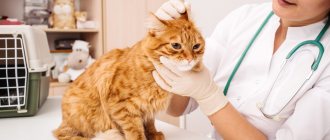Owners often note that a sterilized or neutered cat urinates with blood, but a similar problem can also affect ordinary pets. When not only urine, but also bloody spots are released from the animal’s urethra, this signals inflammation of the bladder, the formation of stones and other problems. It is impossible to independently determine the source of blood when excreting urine, so you should contact a veterinarian to prevent complications.
Why the problem is alarming: veterinarians name the main reasons
When a cat pees in small portions with blood, this is the first sign of the development of a serious disease in the urinary system. The problem is often observed in castrated cats. The disorder is caused by urolithiasis. Some owners believe that the development of pathology is influenced by dry food in the diet, but veterinarians dispel this myth and focus on the fact that the main source of the problem is low-quality products, and good food is not capable of causing the disease. In a sterilized and normal cat, bloody urine is a consequence of problems with excess weight, lack of activity and other factors against which urolithiasis progresses.
An equally common reason why a cat experiences frequent urination with blood clots is mechanical damage to the organ. The problem appears after a fall, sterilization, or auto injury. There are other factors that cause a kitten to urinate blood:
- Infectious diseases. When an infection enters the bladder, urethra, or kidneys, the pet pees red or pink urine. A young cat encounters this disorder, but more often the infectious pathology affects adults who are over 7 years old.
- Neoplasms. If a cat often walks around in a small way, and urine comes out drop by drop and with blood, then this indicates tumor processes. The tumor can be benign and malignant, with the latter having a less positive prognosis.
- Cystitis of the idiopathic type. British Fold, Scottish and other cat breeds suffer from inflammation in the bladder. Owners find that the pet constantly marks throughout the house, meows loudly and urine comes out in small amounts with blood.
Other signs associated with hematuria
The owner needs to take a closer look at the pet's behavior. If a cat starts going to the toilet in the wrong place, then there is a high probability that this is not because it is harmful, but there are problems. It may be painful for your pet to pee and the litter box is associated with pain. Therefore, the animal chooses other places, softer ones - a sofa, a blanket.
Most pathologies of the urinary system have similar symptoms.
In addition to changes in the color of urine, the following symptoms indicate the occurrence of the disease:
- It hurts for the cat to urinate, she meows when she goes to the toilet in a small way.
- Can pee only in small portions, but often.
- Doesn't go to the toilet for a long time.
- Takes characteristic poses to urinate.
Systemic symptoms often appear: lack of appetite, vomiting, weakness.
Symptoms to help recognize the problem
The first sign of the disease is a frequent urge to urinate, but little urine comes out.
When a cat pees constantly and little, and bloody impurities are observed, this indicates a problem. A healthy pet's urine color has a slight yellowish or orange tint. In the early stages, hematuria often remains unnoticed, since in addition to blood, no other signs are recorded in the urine. Soon the animal begins to pee frequently drop by drop and an additional clinical picture is observed:
- problems with appetite;
- high body temperature in cats;
- apathetic and lethargic state;
- restlessness during urination;
- urine with mucus and blood;
- reluctance to pee in the tray, as a result of which the owners find small puddles throughout the house.
Symptoms of pathology
Despite the fact that the main manifestation of hematuria is a change in the color of urine, there are a number of other symptoms that indicate the development of the disease. The signs can be clearly visible to an attentive owner. Among them, the most obvious are:
- frequent urination;
- deterioration of health;
- loss of appetite;
- decreased activity, drowsiness.
You may notice anxiety when going to the toilet, excessive fussiness. The pet begins to meow frequently, and sometimes there is a slight increase in body temperature due to the development of infection. The pain forces the cat to urinate in different places and then lie down on its stomach on the cool floor. The pet loses interest in what is happening around and tries to hide in a dark place so that no one will touch it.
Tests and other diagnostic methods
If your cat falls and pees blood, you should immediately contact a veterinary clinic. To find out the source of the problem and select treatment, the specialist conducts special diagnostic studies. The main method of determining the cause of red urine is its analysis. For a reliable result, you need to know how to correctly collect the material. For diagnosis, it is necessary to deliver urine as soon as possible, but no later than 4 hours from the moment of its collection. When collecting analysis from a cat, adhere to the following rules:
- Pre-rinse the tray with hot water.
- Sea stones are placed at the bottom of the cat litter or left without any filler at all.
- The finished urine is poured into a clean container and submitted for analysis.
- Before the study, you should feed the animal no later than 6 hours before collecting the material.
To make a diagnosis, it is necessary to carry out a number of procedures, including ultrasound examination of the abdominal organs.
When blood in the urine of a neutered cat or an ordinary pet is complemented by other alarming symptoms, then, as a rule, a urine test alone will not be enough. To do this, the cat needs to do additional diagnostic procedures:
- blood biochemistry;
- coagulogram;
- bacterial culture of urine;
- ultrasound diagnostics of organs localized in the abdominal cavity;
- X-rays using a contrast agent;
- cystoscopic examination.
If urine is excreted in drops and with blood against the background of a tumor in the genitourinary system, then the cat is prescribed histology to determine the nature of the tumor and select further treatment.
Establishing diagnosis
If you notice blood in your pet's urine, you should immediately contact your veterinarian. During the visit, a specialist will examine the animal and perform a series of diagnostic procedures to identify the causes of blood and make a diagnosis.
The examination includes:
- Studying the medical history : with the help of a specialist responsible for storing data, the veterinarian will obtain a history of visits to the clinic. From the owner’s words, information will be collected about the animal’s behavior, changes in the environment and the pet’s daily schedule, as well as other important points that were noticed by the owner.
- Physical Exam : At the appointment, the veterinarian will examine the animal.
- Blood and urine tests: the results will show the condition of the cat’s internal organs, as well as the presence or absence of dehydration, inflammation in the bladder, and infections.
- Sensitivity test and urine culture: Ideally, urine collection should be done through cystocentesis, a procedure in which a needle is inserted into the bladder through the abdominal wall.
A urine culture is a way to identify the specific bacteria that may be causing a urethral infection. Using this method, a urine sample is placed in a special environment that promotes the growth of bacteria for subsequent identification of the microorganism.A sensitivity test is carried out to find the most effective antibiotic that can fight the identified bacterium.
- X-ray and ultrasound : tests are designed to detect changes in organs and detect urinary stones.
What to do and how to provide first aid to an animal?
When a young cat often pees or an old cat suffers from bloody impurities in the urine, then you should not delay treatment. Owners can help the animal at home by doing the following:
- Provide the pet with peace and place it in a dry room.
- The cat should drink freely, and the liquid must always be changed so that it does not stagnate.
- Give the animal food with a liquid consistency.
- Give your cat decoctions based on bearberry or parsley, which are disinfectants.
- Drinking a decoction of juniper and horsetail, through which it is possible to reduce the inflammatory reaction.
Symptoms of diseases of the gastrointestinal tract
Signs of gastrointestinal diseases depend on the type of disease and the cause of its occurrence. One of the main symptoms that most clearly signals the presence of gastrointestinal diseases is pain.
The location of the pain may indicate the following problems2:
- heaviness after eating or abdominal discomfort may be associated with a lack of digestive enzymes in the intestines;
- pain in the upper third of the abdomen can be associated with inflammation of the walls of the stomach, intestines and lower esophagus or appear with ulcerative lesions of the stomach and duodenum. Additional symptoms of these diseases are nausea and vomiting;
- pain in the right hypochondrium often signals inflammation of the gallbladder - cholecystitis;
- pain in the left hypochondrium may be a sign of gastritis and other inflammatory diseases of the gastrointestinal tract. If the pain is severe and girdling in nature, then during the examination the doctor pays special attention to the condition of the pancreas;
- pain in the lower abdomen can be a sign of appendicitis and intestinal infections.
Most gastrointestinal diseases are not limited to abdominal pain. A person may also be bothered by 2: Diarrhea. In chronic form, it may indicate hepatitis, cholecystitis, pancreatitis and colitis; Constipation. Gastroenterologists call constipation bowel movements less than 3 times a week. This symptom often accompanies dysbiosis, irritable bowel syndrome; Flatulence. Excessive accumulation of gases in the intestines and stomach can be associated with colitis, pancreatitis and dysbiosis; Nausea and vomiting; Frequent attacks of heartburn, which are caused by gastroesophageal reflux or gastritis with high acidity.
Necessary treatment
Taking into account all the symptoms and based on the examination, the veterinarian prescribes special treatment.
If a cat develops blood after castration or a pregnant cat suffers from bloody impurities in the blood, then it is necessary to urgently contact a veterinarian to determine the source of the pathology. Treatment of the animal is required depending on why it is peeing blood and taking into account additional symptoms. The table shows different treatment methods.
| Deviation | Therapeutic measures |
| Diseases of inflammatory nature | If your pet has peed bloody urine once, the veterinarian will prescribe anti-inflammatory, antispasmodic and painkillers. |
| Advanced diseases | Taking oral or intramuscular antibiotics |
| Using vitamin complexes and herbal decoctions to strengthen the immune system | |
| Internal bleeding | Using medication to stop bleeding |
| Urolithiasis | If the cat pees with blood and little, then this indicates stones in the urinary system, which can be removed with medications and nutritional correction. |
| If there is difficulty urinating, urine is removed using a catheter | |
| In advanced cases, surgery is possible | |
| Dehydration | Injection of glucose and saline solutions into a vein |
| Some types of poisoning | Vitamin K1 intake |
Do you have a vitamin D deficiency?
Vitamin D levels can be determined using a blood test for 25(OH)D levels.
- less than 20 ng/ml (50 nmol/l) is defined as deficiency;
- from 20 to 30 ng/ml (from 50 to 75 nmol/l) - insufficient level;
- more than 30 ng/ml (75 nmol/l) is an adequate amount.
According to the clinical guidelines of the Russian Association of Endocrinologists, it is recommended to maintain the concentration of 25(OH)D in the range from 40 to 60 ng/ml (100-150 nmol/l).
Read also: Did your dog eat meat with maggots?
Our body can independently produce calciferol, but there are risk groups that need to control the level of this microelement:
- people with dark skin color, as the ability to absorb UV radiation is reduced;
- working at night, constantly staying indoors or preferring closed clothing;
- people with metabolic disorders (in particular obesity);
- elderly population (with age, the ability to synthesize the vitamin decreases);
- those who prefer a restrictive eating style, as a result of which the diet does not contain sufficient amounts of vitamin D;
- low birth weight children;
- women taking oral contraceptives.
Natural factors for the appearance of uncharacteristic discharge
It happens that bloody liquid in the urine appears due to natural situations. This is only possible in females due to their physiological characteristics. The presence of red spots in urine can be caused by 2 reasons:
- Estrus is when blood clots from the genitals are washed away by urine, which gives it a pink tint. The amount of such discharge is insignificant and by the end of estrus it may be completely unnoticeable.
- The period after childbirth, when vaginal discharge continues after lambing. This lasts about 3 days and is considered normal. After natural cleansing of the genital organs, urine acquires a normal color. If this does not happen, then you need to quickly contact a specialist, since we are talking about bleeding.
The listed factors do not give cause for concern and a visit to the doctor. However, prolonged discharge indicates serious health problems for the female.
What should you pay attention to?
Hematuria is indicated by blood in the urine, which can cause it to change color (for example, red). With severe internal bleeding, the cat develops anemia, during which it loses motor activity, gains weight poorly, and often refuses the food offered.
Often, the release of blood in the urine is accompanied by a deterioration in the general condition of the pet. He tries to lie down most of the time, plays less, and practically does not react to various external stimuli (for example, loud sounds).
Note! In 6 out of 10 cases of hematuria, the cat will experience vomiting and other forms of eating disorder (for example, loss of appetite).
Additional factors to consider:
- bloody urinary incontinence,
- the cat often pees with blood,
- blood impurities are also excreted in the feces.
If you notice that your cat has blood in his urine, pay attention to how he urinates. Usually this process is accompanied by severe painful sensations, so the pet rarely goes to the tray and meows loudly.
What to do if your cat is peeing blood?
If it is not possible to immediately contact a veterinarian if blood is detected in the urine, provide first aid to your pet. When carrying, be as careful as possible, especially if the cat has recently been sterilized or has been injured.
Your actions:
- Provide peace . Don't let your pet go outside. Place him in a warm and quiet place where he feels comfortable and safe;
- Don't give him drugs . Do not self-medicate. Any mistake with the dosage or method of administration will lead to irreversible consequences;
- Nutrition . Eliminate dry and solid food from your cat's diet. Ensure constant availability of fresh water.
Do not hesitate to visit the veterinarian - contact him as soon as possible.
Prevention of hematuria in cats
To prevent hematuria in cats:
- avoid overcooling the cat;
- ensure adequate water intake;
- ensure proper nutrition for the cat, especially avoid low-quality commercial feed;
- carry out regular examinations by a veterinarian;
- provide periodic laboratory monitoring of blood and urine parameters, especially in cats over 5 years of age;
- prevent your cat from eating toxic substances;
- timely treatment of foci of chronic infection, especially gingivitis, which is often ignored;
- promptly suppress allergic reactions;
- carry out timely vaccination and deworming.
Conditions in which hematuria occurs
Hematuria develops in a number of diseases:
- inflammatory diseases of the urinary system: pyelonephritis (inflammation of the renal pelvis);
- cystitis - inflammation of the mucous membrane of the bladder;
- urethritis - inflammation of the urethra (urethra); In addition to hematuria, in inflammatory diseases the following is noted: pain syndrome (in pain, the cat hunches its back);
- painful and frequent urination;
- fever;
- decreased activity and appetite in the cat;
- deterioration of general health;
The list of diseases that manifest as hematuria is extensive. For correct diagnosis and prescription of therapy, medical assistance is necessary, as well as the possibility of conducting additional research. Self-diagnosis and self-medication will not lead to success and will worsen the prognosis of the disease. Before visiting the clinic, to alleviate your pet’s condition, you need to:
- give the cat complete rest;
- place the cat in a warm room on a bedding, avoid drafts;
To alleviate the cat's condition, you need to provide her with warmth and peace.
- feed only liquid, easily digestible food, do not give solid foods;
- provide plenty of water to drink;
- drink decoctions of juniper fruits, horsetail herbs, bearberry, parsley root;
- give an intramuscular injection of No-shpa 1–2 mg per kg of cat weight.
Baralgin is often recommended to relieve pain in a cat, but at the stage of first aid, when the diagnosis is still unclear, it should not be used. In addition, due to belonging to the group of non-steroidal anti-inflammatory drugs, Baralgin can contribute to the continuation of hematuria. The exact dose of Baralgin, as well as the need for its use, will be determined only by a doctor. The best help for an animal is immediate delivery to the clinic.
The best first aid for a cat with hematuria is its immediate delivery to the clinic.











